|

|
Wolverhampton's Blue
Plaques
Queen Street
|
 |
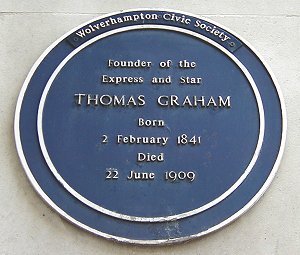 |
Commemorating:
Thomas Graham who founded the Express & Star.
Sponsored by:
Express & Star
Location:
On the right-hand side of the Express &
Star building in Queen Street. |
Thomas Graham, who was a weaver from Dunfermline,
and his family, moved to
Wolverhampton after automation had hit the local weaving industry.
At the age of 21 he purchased a bacon curing business in
Wolverhampton and soon became a magistrate and a member of the town
council. His ambition was to run a newspaper. He was a fervent
Liberal and was dissatisfied with the Conservative views of the
Evening Express which was the only Wolverhampton newspaper of the
day. |
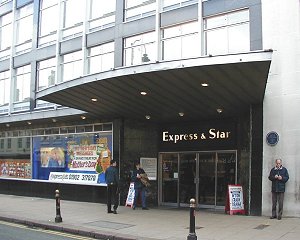 |
One day in the 1860's, Thomas travelled by train to London
and met Andrew Carnegie, the American steel tycoon. He was also from
Dunfermline and the pair became life long friends. On 28th June,
1880, the Evening Star newspaper was launched by some of Thomas's
Liberal friends. It cost a halfpenny and consisted of just four pages.
In 1882 Thomas persuaded his friend Carnegie to buy the newspaper and it
was soon a big success, selling 10,000 copies a day. In 1883 the Midland
News Association was formed with Thomas on the board. In 1884 the Star
brought the Express and the two newspapers soon merged as the Evening
Express & Star. In 1889 the word Evening was dropped and the newspaper
became the Express & Star. Carnegie eventually pulled out of the
newspaper, giving the power of attorney for his interest to Thomas, who
could now outvote the other members of the board. He soon paid them off
and become sole proprietor of the Express & Star. This only lasted for a
short while as he died in 1909 after a long illness.
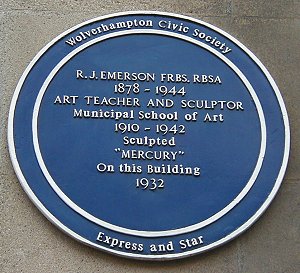 |
Commemorating:
R. J. Emerson, art teacher and sculptor.
Sponsored by:
Express & Star
Location:
On the left-hand side of the Express &
Star building in Queen Street. |
| The plaque is on the far left of the photograph. |
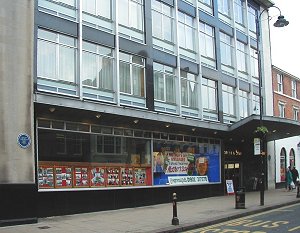 |
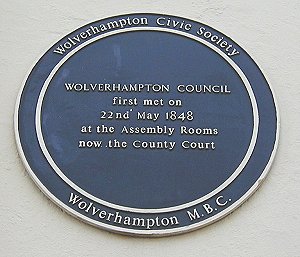 |
Commemorating:
The first meeting of Wolverhampton Council on 22nd May 1848.
Sponsored by:
Wolverhampton Metropolitan Borough
Council.
Location:
On the front of the Walkabout public
house in Queen Street. |
| The first municipal elections took place in the town
on 12th May 1848. There were eight wards which roughly reflected the
parish boundaries. The council consisted of 36 councillors and 12
aldermen. The council's first home was the Assembly Rooms in Queen
Street, which later became the County Court. The council later moved
to premises in Garrick Street, and eventually to the Red Lion Hotel
in North Street. The council purchased the hotel and adapted it for
council use. Eventually the adjoining properties were purchased and
the buildings were demolished to make way for the town's first town
hall. |
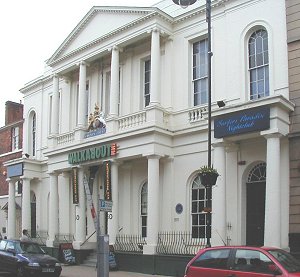 |
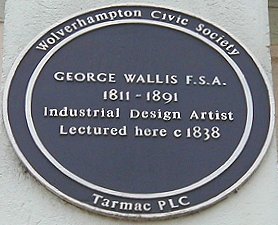 |
Commemorating:
George Wallis, industrial design artist.
Sponsored by:
Tarmac P.L.C.
Location:
On the front of the Armed Forces Careers
building in Queen Street. The plaque can be seen by the
right-hand door of the building, formerly the Mechanic's
Institute which opened in 1836.
|
| Wallis was born in Wolverhampton in 1811 and was
brought up by his uncle and aunt on the early death of his parents.
He was deaf. He attended the grammar school. He soon
became an artist, employed by Ryton and Walton at Turton Hall to
paint the decorative centres of the best japanned ware; and he
taught art. He promoted one of the country's first Industrial
Arts exhibitions, which he put on in this building. He was
then appointed art master of the School of Design in Manchester and
then of that in Birmingham. He was then appointed Keeper of
Art Treasures at the South Kensington Museum (the V & A). He
was a Deputy Commissioner of the Great Exhibition of 1851.
Throughout his career he was "ever ready to help the good old town
and forward its interests". |
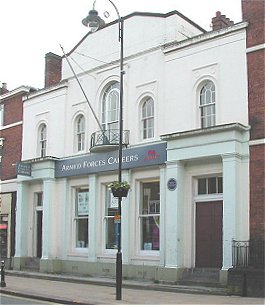 |
| George Wallis, from the portrait in Jones's
Historical Sketch of the Literary Institutions of Wolverhampton. |
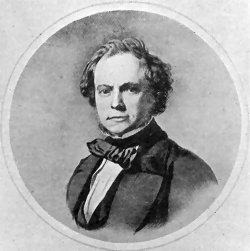
|
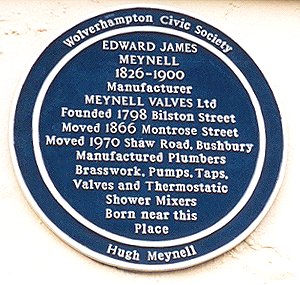 |
Commemorating:
Edward James Meynell, manufacturer.
Sponsored by:
Hugh Meynell
Location:
32a Queen Street.
|
| The plaque is to be found on the front of Kevin
Fisher's Chiropodist shop in Queen Street. |
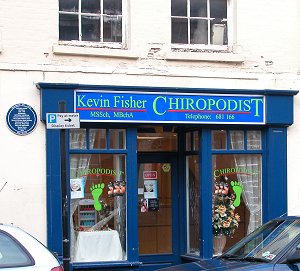 |
|












